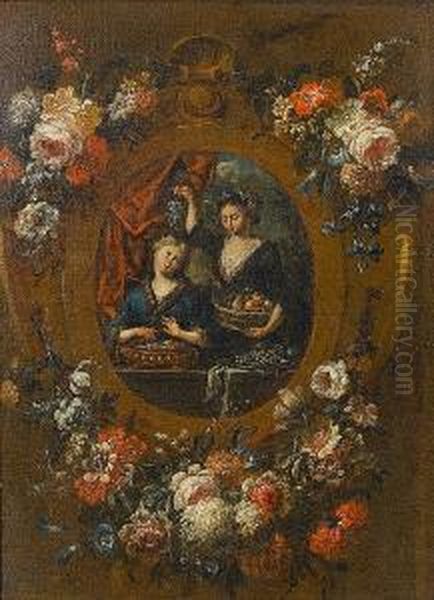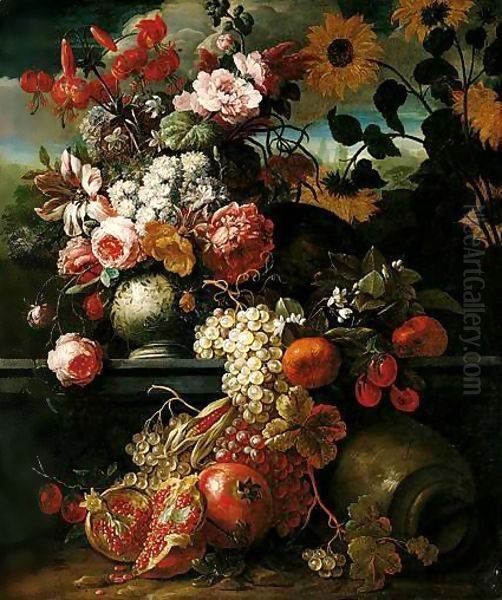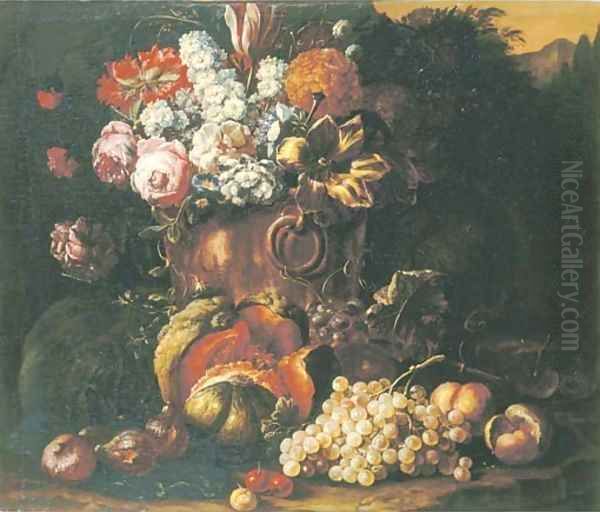Gaspar Pieter Verbruggen the Younger, also known as Gaspar Peeter Verbruggen II, stands as a significant figure in the rich tradition of Flemish still life painting. Born in the bustling artistic hub of Antwerp in 1664 and passing away there in 1730, his life spanned a period of transition in the Low Countries, yet his work remained firmly rooted in the exuberant spirit of the late Baroque. He specialized in the depiction of flowers and fruit, transforming humble botanical subjects into elaborate, decorative compositions that adorned the homes of the affluent and contributed to the enduring legacy of Flemish art.
Verbruggen was celebrated for his technical proficiency, his seemingly effortless brushwork, and a profound understanding of the natural world, particularly botany. His paintings are characterized by their vibrant palettes, dynamic arrangements, and often monumental scale, distinguishing him within the specialized genre of still life. While deeply influenced by the Baroque aesthetic, he developed a personal style that emphasized elegance, decorative richness, and a certain painterly freedom.
Artistic Lineage and Early Training in Antwerp
Gaspar Pieter Verbruggen the Younger was born into an artistic family. His father, Gaspar Peeter Verbruggen the Elder (1635–1681), was himself a successful still life painter in Antwerp. This familial connection undoubtedly provided the young Gaspar Pieter with his initial exposure to the art world and likely his foundational training. Growing up in Antwerp, a city that had been a powerhouse of European art for over a century thanks to masters like Peter Paul Rubens and Anthony van Dyck, Verbruggen was immersed in a culture that valued artistic skill and innovation.

He formally trained under his father, learning the techniques and compositional strategies specific to still life painting. Following his father's death in 1681, the young Verbruggen continued his development, likely absorbing influences from other prominent Antwerp artists. He was admitted as a master painter into the prestigious Antwerp Guild of Saint Luke in the guild year 1677-1678, an remarkably young age which suggests precocious talent, though some sources suggest this might refer to his father, and the younger Verbruggen became master later. Regardless, his acceptance into the guild marked his official entry into the professional art world.
The Guild of Saint Luke was the central institution governing artists and artisans in Antwerp and many other European cities. Membership was essential for practicing professionally, taking on apprentices, and selling work within the city. Verbruggen's involvement with the Guild grew over time, reflecting his rising status within the Antwerp artistic community.
Flourishing in Antwerp: The Guild and Early Success
During the late 17th century, Verbruggen established himself as a leading flower painter in Antwerp. His works from this period often feature the complex, overflowing arrangements characteristic of the High Baroque. He demonstrated a remarkable ability to render the varied textures of petals, leaves, and fruit, capturing the play of light across their surfaces with lively, confident brushstrokes. His compositions were typically dynamic, often asymmetrical, and filled with a sense of abundance and movement.
His reputation grew, and his skills were formally recognized by his peers when he was elected deacon of the Guild of Saint Luke for the guild year 1691-1692. This was a position of considerable honour and responsibility, involving administrative duties and representing the interests of the guild members. It signified his standing as a respected master within the Antwerp art scene.
As was customary for prominent members, Verbruggen donated a work to the Guild upon taking office. This painting, a magnificent Garland of Flowers around a Statue of Apollo, is now housed in the Royal Museum of Fine Arts, Antwerp. This piece exemplifies his skill in creating elaborate floral decorations, a format popularized earlier by artists like Jan Brueghel the Elder and the Jesuit painter Daniel Seghers. In such works, the meticulously painted flowers frame a central motif, often a sculpture, a religious image, or a portrait.
Signature Style: Baroque Exuberance and Botanical Detail

Verbruggen's style is firmly situated within the Flemish Baroque tradition, known for its dynamism, rich colours, and dramatic intensity. However, he adapted these principles to the genre of still life, creating works that were both opulent and elegant. His flower paintings are often characterized by their sheer abundance; vases overflow with blooms, and garlands cascade across the canvas. He favoured compositions that suggested movement and vitality, a departure from the more static arrangements of earlier generations like Ambrosius Bosschaert the Elder.
He possessed a deep knowledge of botany, evident in the variety of flowers depicted in his works. Tulips, roses, peonies, carnations, narcissi, viburnum, poppies, and many other species are rendered with recognizable detail. However, like many Baroque flower painters, Verbruggen often took artistic license, combining flowers that bloomed in different seasons into a single bouquet. This practice aimed for maximum decorative effect and symbolic richness rather than strict botanical accuracy within a single moment in time.
His technique involved fluid, visible brushwork, which imbued his paintings with a sense of immediacy and life. While capable of rendering fine detail, his overall approach was often more painterly and less focused on microscopic precision than, for example, the later Dutch fijnschilder (fine painter) Jan van Huysum. His style has often been compared to that of the influential French flower painter Jean-Baptiste Monnoyer, who also specialized in large-scale, decorative floral pieces for aristocratic interiors. Verbruggen shared Monnoyer's flair for grandeur and elegance.
Verbruggen frequently incorporated classical elements into his compositions, such as sculpted stone vases, urns, plinths, or architectural fragments. These elements added a sense of formality and grandeur, linking his still lifes to the classical tradition revered during the Baroque era. Sometimes, these settings included reliefs or sculptures depicting mythological scenes or figures, further enriching the painting's narrative or symbolic potential.
Expanding Horizons: The Move to The Hague
Despite his success and recognition in Antwerp, including serving as deacon of the Guild, Verbruggen encountered financial difficulties towards the end of the 17th or early in the 18th century. Sources indicate that he fell into debt, a situation serious enough to compel him to leave his native city. Around 1706, he relocated to The Hague, the administrative centre and diplomatic capital of the Dutch Republic.
The Hague offered new opportunities. It was a city with a wealthy clientele interested in decorating their residences in the latest style. Verbruggen joined the Confrerie Pictura, the artists' confraternity in The Hague, which functioned similarly to the Guild of Saint Luke in Antwerp. This membership allowed him to work and take on commissions in the city.

During his time in The Hague, Verbruggen engaged in significant collaborations, most notably with the painter Mattheus Terwesten (often referred to as Matthew Terwesten). Terwesten, along with his brother Augustinus Terwesten, specialized in history painting and large-scale decorative schemes, including ceiling paintings and wall panels, often featuring allegorical or mythological figures.
Collaboration and Decorative Projects
The partnership between Verbruggen and Mattheus Terwesten proved fruitful. In many decorative projects for the grand houses of The Hague, Terwesten would paint the central figurative scenes or the figures within architectural frameworks, while Verbruggen would contribute the surrounding elements – typically lavish garlands of flowers, fruit swags, and other ornamental details. This division of labour was common in large-scale decorative commissions, allowing specialists to contribute their respective skills.
This collaborative work further emphasized the decorative aspect of Verbruggen's art. His floral elements were designed to integrate seamlessly with Terwesten's figures and the overall architectural setting, creating immersive and opulent interiors. His style during this period perhaps leaned even more towards the decorative and elegant, aligning with the tastes prevalent in The Hague. His work from this time is seen as closer in spirit to the decorative French style of Monnoyer than the meticulous realism of Dutch contemporaries like Rachel Ruysch.
Examples of specific commissions or surviving collaborative works are sometimes difficult to pinpoint definitively, but the association is well-documented and highlights an important phase of Verbruggen's career where his art functioned explicitly as part of larger decorative ensembles.
Notable Works and Recurring Themes
Throughout his career, Verbruggen produced a significant body of work, primarily focused on floral and fruit still lifes. Some key examples and recurring themes include:
Elaborate Flower Bouquets: Often set in ornate stone or metal vases, these compositions showcase a wide variety of blooms in dynamic, overflowing arrangements. Works titled Fruit and Flowers or Still Life with Flowers in a Vase fall into this category. Examples like Still life of roses, narcissi, carnations, convolvulus, and orange blossom highlight his ability to capture diverse floral forms.
Garlands and Swags: Following the tradition of Seghers and Brueghel, Verbruggen excelled at painting floral garlands, often surrounding a central cartouche, niche, sculpture, or even a portrait. His Garland of Flowers around a Statue of Apollo is a prime example. These works often carried symbolic weight, with the flowers potentially alluding to themes like transience (vanitas), devotion, or abundance.
Works with Figures: While primarily a still life painter, some of Verbruggen's works incorporate figures, often children or putti interacting with the flowers or fruit. Children with Flowers around a Goat is one such example. In other cases, particularly during his Hague period, the figures were painted by collaborators like Terwesten. A work depicting Marie-Anne de Bourbon, première Mademoiselle de Blois, duchesse douairière de Conti, dated 1680, is sometimes attributed to him, though the early date raises questions – it might be by his father, a collaboration, or indicate very early maturity if by the younger Verbruggen.
Decorative Panels: Especially during his collaboration phase, he likely produced panels featuring primarily floral and fruit arrangements designed as part of room decorations. Vases de pierre remplis de fleurs (Stone Vases Filled with Flowers) likely represents this type of grand decorative piece.
Allegorical Still Lifes: Some works, like the Allegorie der Flora (Allegory of Flora), explicitly engage with mythological themes, using the abundance of flowers to represent the goddess of spring and blooms.
His works consistently display a masterful handling of colour, light, and texture, creating visually stunning compositions that celebrate the beauty of the natural world within a distinctly Baroque framework.
Influence, Students, and Legacy
Gaspar Pieter Verbruggen the Younger played a role in transmitting the traditions of Flemish flower painting to the next generation. He trained several pupils who went on to become artists in their own right. Notable among them were:
Balthasar Hyacinth Verbruggen: His own half-brother, who also specialized in still life painting, continuing the family tradition.
Jacob Melchior van Herck (or Van Herp): Another Antwerp painter known for his flower and fruit still lifes, clearly influenced by Verbruggen's style.
Frans d'Olivera (or de Olivera): Listed as his pupil, though less is known about his subsequent career.
Through his students and the general influence of his popular style, Verbruggen contributed to the continuation of the Flemish floral tradition into the 18th century. Furthermore, prints were made after his still life compositions, which helped to disseminate his style more widely and catered to a broader market of art enthusiasts who could not afford original paintings.
His legacy lies in his contribution to the late Baroque decorative still life. He successfully blended the Flemish tradition of detailed observation, inherited from artists like Jan Brueghel the Elder and Jan Davidsz. de Heem, with a more fluid, painterly technique and a grand, decorative sensibility suited to the tastes of his time. He stands as a key representative of the final flourishing of the Antwerp school of flower painting before artistic centres shifted decisively elsewhere.
Financial Struggles and Final Years
Despite the artistic recognition he received in both Antwerp and The Hague, Verbruggen's later life was marked by persistent financial instability. Even during his potentially lucrative period in The Hague, collaborating on prestigious decorative projects, contemporary accounts suggest he struggled to manage his finances, with his expenditures often exceeding his income. This inability to achieve lasting financial security plagued him throughout his career.
The reasons for his financial woes are not entirely clear from historical records, but they were severe enough to force him to make difficult decisions. Having initially left Antwerp due to debt, he found himself unable to sustain his lifestyle in The Hague. Eventually, likely around 1723, he made the decision to return to his native Antwerp.
His return was not triumphant. He arrived back in Antwerp impoverished. The Guild of Saint Luke, the institution where he had once served as deacon, provided him with some support in his final years. He was employed by the Guild in a modest capacity, possibly as a 'knaap' or servant, performing minor tasks. This poignant end stands in stark contrast to the artistic heights he had achieved. Gaspar Pieter Verbruggen the Younger died in Antwerp in March 1730, reportedly as a poor man.
Collections and Market Recognition
Despite the financial difficulties faced by the artist during his lifetime, works by Gaspar Pieter Verbruggen the Younger found their way into significant collections and continue to be appreciated on the art market today. His paintings demonstrate the enduring appeal of Flemish Baroque still life.
Major public collections holding works by Verbruggen include:
The Royal Museum of Fine Arts, Antwerp: Holds the important Garland of Flowers around a Statue of Apollo.
Palais des Beaux-Arts, Lille, France: Possesses examples of his work.
Châteaux de Versailles et de Trianon, France: Collections here also include paintings attributed to him, reflecting the international reach of Flemish art.
Other museums across Europe likely hold works, sometimes possibly under different attributions due to the similarities between his work, his father's, and his students'.
His paintings appear periodically on the international art market, achieving respectable prices that reflect his status as a recognized master of the genre. Auction records from houses like Sotheby's and Christie's show sales of his works over the years:
A Still life of roses, narcissi, carnations... sold at Sotheby's London in 2019 for between £4,000-£6,000.
Vases de pierre remplis de fleurs was offered at Sotheby's London in 2019 with an estimate of €6,000-€40,000 (the wide estimate might reflect condition or attribution questions).
A work depicting a Young Woman, a Putto and a Garland of Flowers was estimated at €15,000-€20,000 at a European auction house in 2024.
His Allegorie der Flora was sold at Sotheby's New York back in 1993.
These records indicate a continued market interest in his decorative and skillfully executed still lifes, confirming his place within the canon of Flemish Baroque painters.
Conclusion: An Enduring Baroque Vision
Gaspar Pieter Verbruggen the Younger represents a fascinating chapter in the history of Flemish art. As a highly skilled flower and fruit painter, he mastered the techniques of his predecessors and contemporaries, creating works of Baroque exuberance and decorative splendour. His career trajectory, from celebrated master and Guild deacon in Antwerp to collaborative decorator in The Hague and finally back to a life of poverty in his hometown, paints a vivid picture of the sometimes precarious existence of artists, even successful ones.
His paintings, characterized by their dynamic compositions, rich colours, and fluid brushwork, capture the transient beauty of nature while serving the decorative demands of elite patrons. Through his collaborations, particularly with Mattheus Terwesten, he contributed to the grand interior designs of the era. His influence extended through his students, ensuring the continuation of the Flemish still life tradition. Though his personal life ended in hardship, his artistic legacy endures in the museums and collections that preserve his vibrant celebrations of flora, testament to his enduring vision as a master of the Baroque still life.